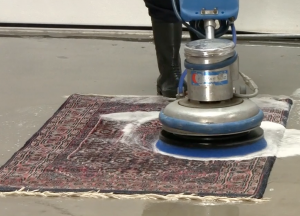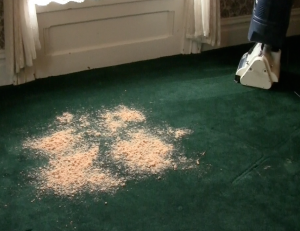
Due to the variety of carpet cleaning methods in use today, it’s important to know what you’re getting when you hire a professional. Photo: Precision Cleaning Services (2016)
It’s often assumed that all carpet cleaning companies use the same cleaning techniques, but this couldn’t be further from the truth. The reality is that today’s carpet cleaners employ a wide range of methodologies, each of which utilizes different concepts, sciences and machinery. That’s why, prior to calling a carpet cleaner, it’s important to familiarize yourself with the different cleaning methods out there so you can make an informed choice. Here are the four most common carpet cleaning techniques being used by professionals today:
Hot Water Extraction (Steam Cleaning)
The most prevalent method in professional use today, hot water extraction relies on heavy-duty machinery to provide a deep, powerful cleaning. First, a hot water solution is shot into the carpet, which creates a combination of force and temperature that dislodges soil particles embedded in the pad. The water is then sucked back up again, taking the displaced materials with it. Because it’s so effective at removing deeply embedded dirt and grime, hot water extraction is the method recommended by most major carpet manufacturers.
Despite its efficacy, hot water extraction has a couple of drawbacks, mostly involving its use of water. First, it uses a lot—anywhere from 50 to 100 gallons for a single home. Second, while most of the water is sucked back out of the carpet, a considerable amount gets left behind. Not only does this result in long drying times (anywhere from four hours to an entire day), but whatever dirt the water contains will remain in the carpet after it has dried. Nonetheless, while hot water extraction may not remove 100 percent of the dirt it dislodges, it still provides a deep, thorough cleaning.

Because it lacks an extraction element, bonnet cleaning is best applied to area rugs and low-pile carpets. Photo: Cole’s Carpet & Upholstery Company (2016)
Bonnet
Bonnet cleaning essentially takes the technique used for buffing hard floors and applies it to cleaning carpet. After the cleaning solution is applied to the carpet’s surface, a rotary machine is used to work it into the fibers with a spinning pad or “bonnet.” However, while this method works well for hard floors, it has several disadvantages when it comes to carpet. Since there’s no extraction element, bonnet cleaning isn’t able to remove dirt so much as push it down into the lower part of the carpet, which results in rapid re-soiling when it resurfaces. Bonnet cleaning is also known to damage and distort the fibers of cut pile carpets, which is why it’s more commonly applied to low-pile carpeting.
Encapsulation
Encapsulation is a cutting-edge method that employs chemical agents like polymers to clean carpet without the need for excessive amounts of water. After being applied to the carpet, the polymers surround or “encapsulate” the soil particles they come into contact with and crystallize them, which causes them to detach from the carpet fibers. When the carpet is subsequently vacuumed, these detached soil particles are readily sucked up, leaving the carpet clean with little residual moisture.
Because of its (mostly) dry treatment, encapsulation both conserves water and reduces drying time—in most cases, the carpet is dry within an hour of service. It’s also less abrasive on the carpet than steam or bonnet cleaning, so there’s little chance of damage. The only potential drawback of encapsulation is it lacks the sheer force of hot water extraction, which limits its effectiveness when it comes to cleaning deeply soiled carpets.

Dry compound contains chemicals that attract and absorb soil before being vacuumed back up. Photo: American Ratings Corporation (2016)
Dry Compound
Similar to encapsulation in both concept and practice, this method relies on a powder-like compound that’s infused with cleaning agents and solvents. This compound is brushed into the carpet, where it subsequently attracts and absorbs soil particles before being removed again by vacuuming. Dry compound has nearly the same benefits as encapsulation (low water consumption and quick drying times), but like encapsulation, it’s not always effective at cleaning thoroughly soiled carpet. Compounds are often biodegradable, but all contain at least some chemical element, so a common concern is that some chemicals may remain in the carpet after cleaning.
Due to each method’s distinctive pros and cons, when deciding which to use in your home, it’s a good idea to assess your particular needs and circumstances. For example, if your carpet has been well-maintained over the years, encapsulation can be a good, water-wise choice. However, if your carpet is very soiled, hot water extraction will likely be a better option, as substantial force may be required to achieve a thorough cleaning. Once you’ve decided on your preferred method, look for a carpet cleaning professional that specializes in it. By being informed about your options, you’ll be able to choose the right carpet cleaning service for your needs.
To find a carpet cleaning professional in your area, visit www.diamondcertified.info.
